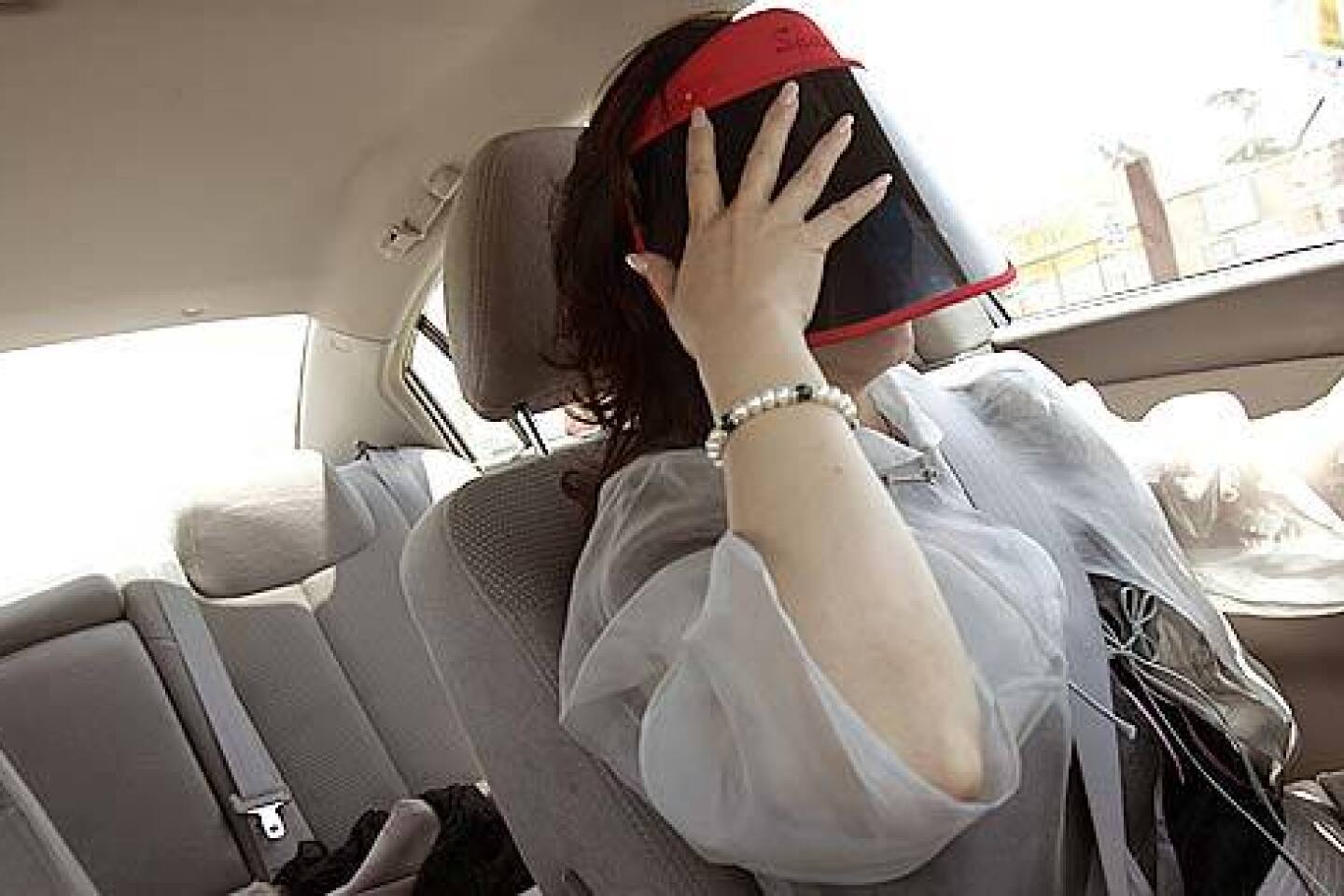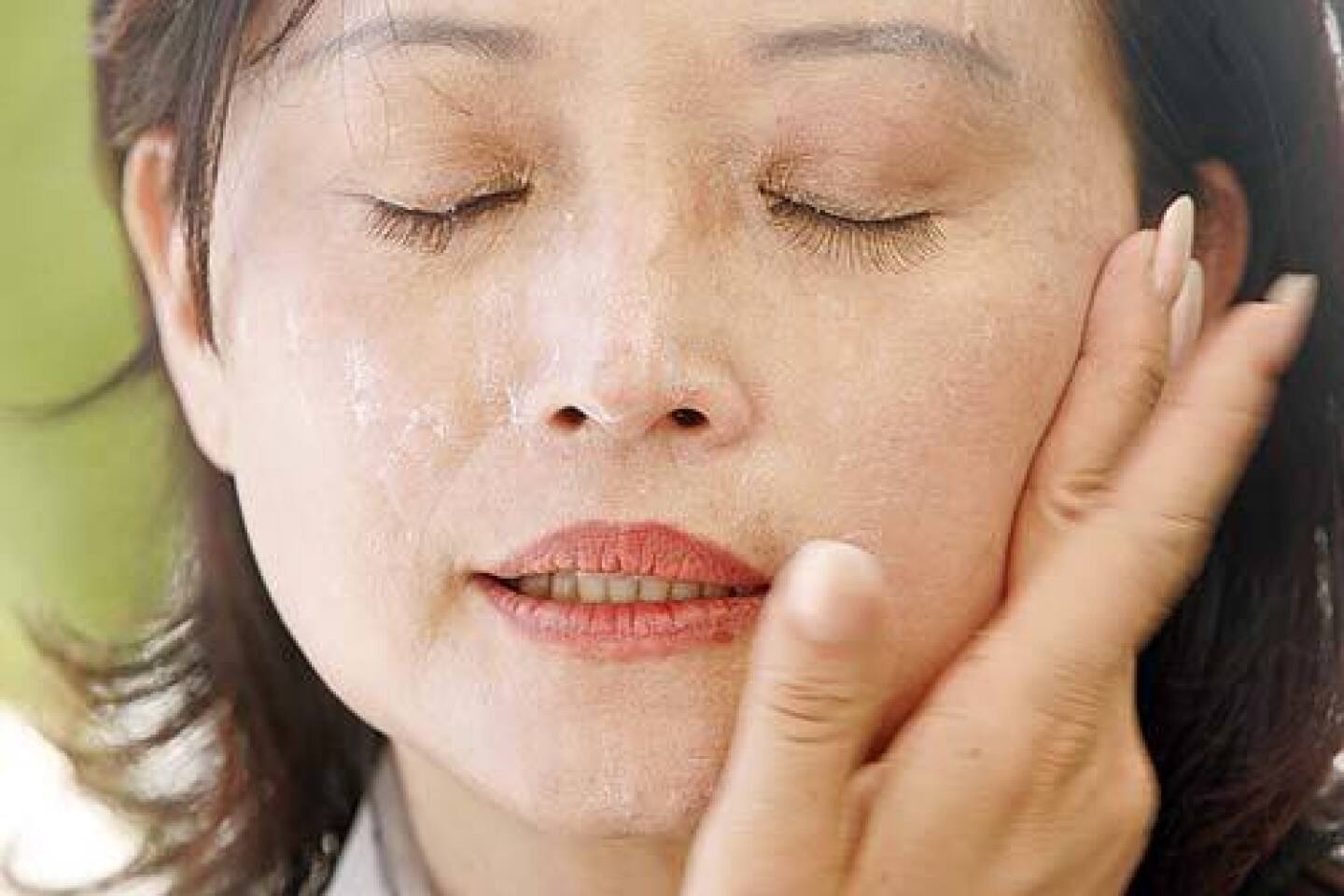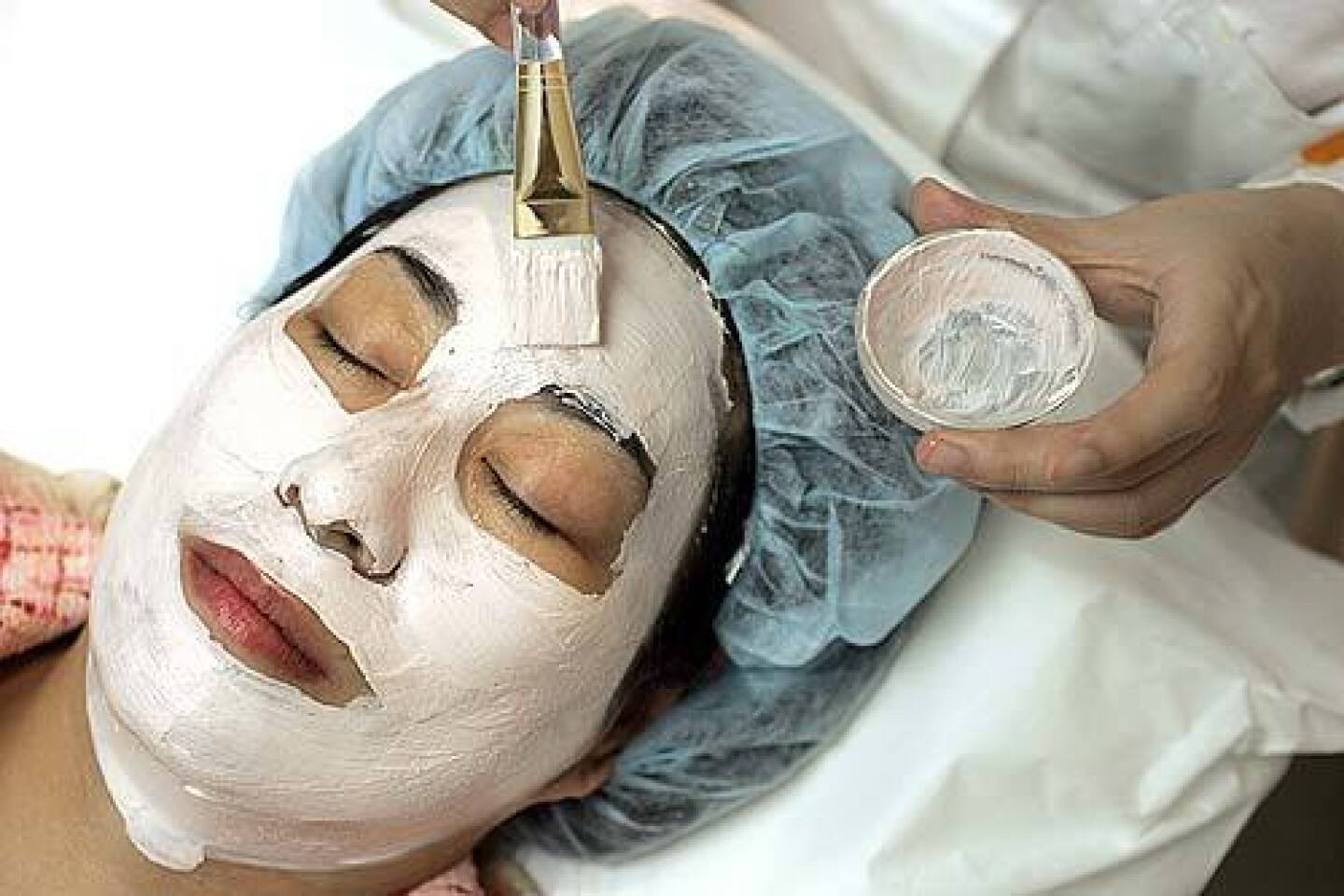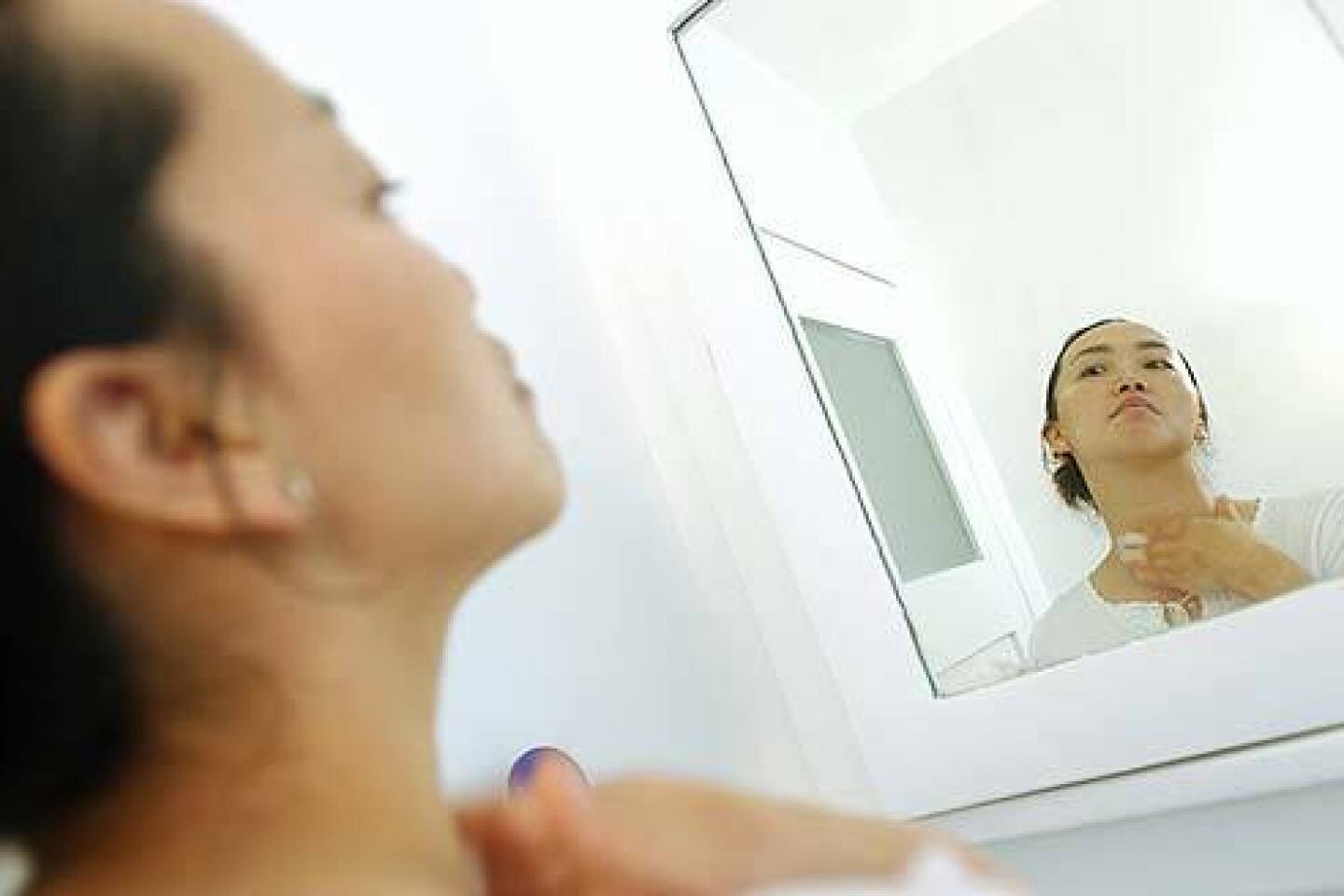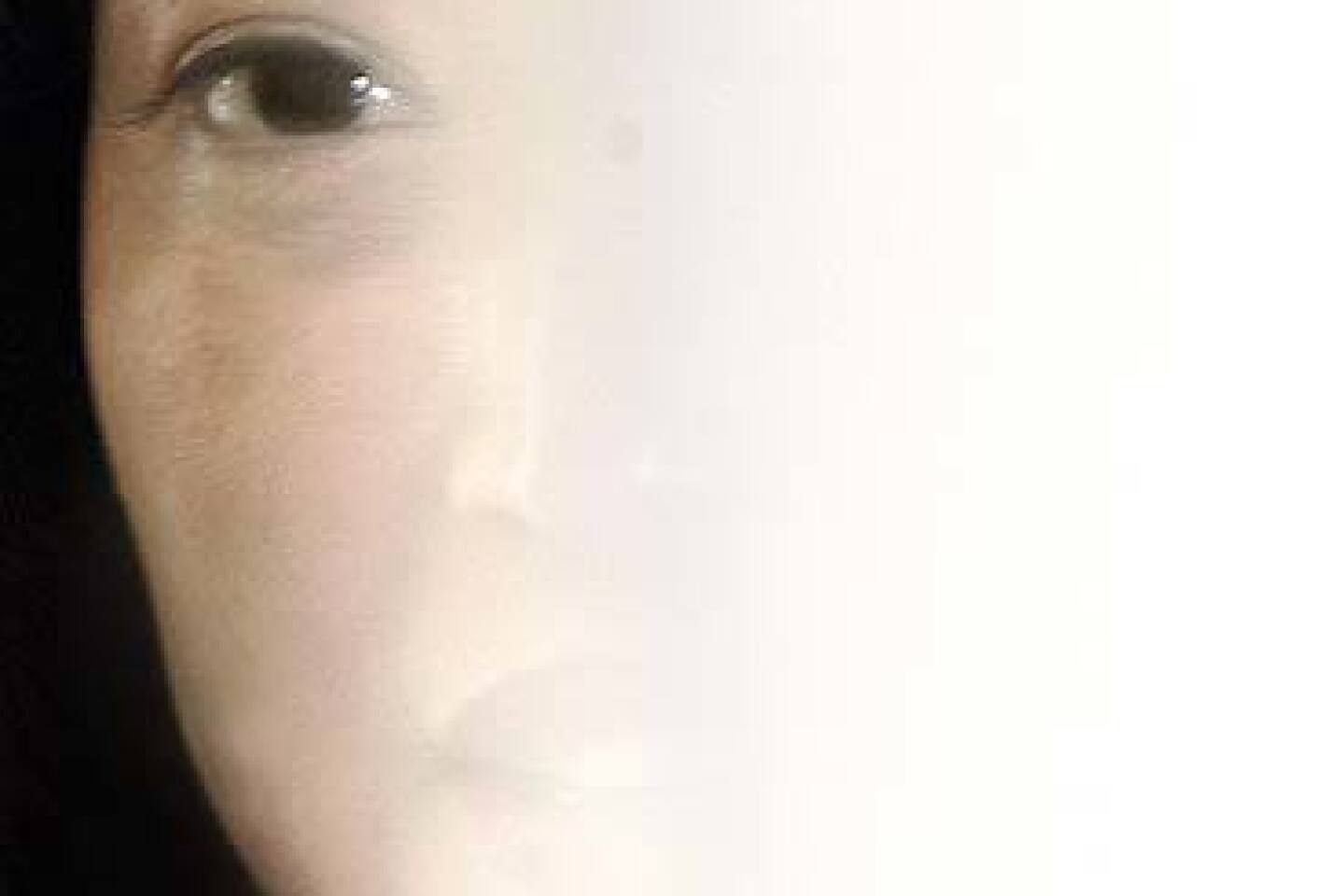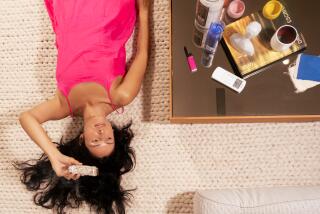Beauty and the Bleach
- Share via
For many Southern Californians, summer is the season for beaches, chaise longues and the quest for the perfect tan.
Not for Margaret Qiu. She and thousands of other Asian American women are going to great lengths to avoid the sun -- fighting to preserve or enhance their pale complexions with expensive creams, masks, gloves, professional face scrubs and medical procedures.
For these women, a porcelain-like white face is the feminine ideal, reflecting a long-held belief that pale skin represents a comfortable life. They also believe it can hide physical imperfections.
“There’s a saying, ‘If you have white skin, you can cover 1,000 uglinesses,’ ” said Qiu, a 36-year-old Chinese immigrant who lives in Alhambra.
Qiu goes through a regimen of skin-whitening products twice a day. She is one of many customers who have turned Asian whitening creams and lotions into a multimillion-dollar industry in the United States.
But that’s just the beginning.
Take a daylight drive through Asian immigrant enclaves like Monterey Park and Irvine, and you’ll see women trying to shield themselves with umbrellas -- even for the short dash from a parking lot into a supermarket. While driving, many wear special “UV gloves” -- which look like the long gloves worn with ball gowns -- to protect their forearms, and don wraparound visors that resemble welder’s masks.
At beauty salons, women huddle around cosmetics counters asking about the latest cleansers and lotions that claim to control melanin production in skin cells, often dropping more than $100 for a set. Beauticians do a brisk business with $65 whitening therapies. Women dab faces with fruit acid, which is supposed to remove the old skin cells that dull the skin, and glop on masks with pearl powder or other ingredients that they believe lighten the skin.
There are doctors who, for about $1,000, will use an electrical field to deliver vitamins, moisturizers and bleaching agents to a woman’s face in a procedure known as a “mesofacial.”
Whitening products have been a mainstay in Asia for decades, but cosmetics industry officials said they have emerged as a hot seller in the United States only in the last four years. Whitening products now rack up $10 million in sales a year, according to the market research firm Euromonitor.
But their popularity has sparked a debate in the Asian American community about the politics of whitening. Qui and others say the quest for white skin is an Asian tradition. But others -- younger, American-born Asians -- question whether the obsession with an ivory complexion has more to do with blending into white American culture, or even a subtle prejudice against those with darker skin.
The market research firm says cosmetics companies have taken note of the sensitivity, saying their Asian skin products in America are intended not for “whitening” but for “brightening.”
“It’s not a politically correct term because it seems to imply that looking Caucasian via a white complexion is the desired beauty goal,” said Virginia Lee, a Euromonitor analyst.
*
Qiu, a 36-year-old native of Xi’an, China, thinks there is nothing politically incorrect about using products that whiten the skin, which are known in Mandarin as mei bai, or “beauty white.”
Qiu, who sells herbal supplements, has used whitening creams for five years and went to Vitativ, a cosmetics store in Monterey Park, one recent morning for a refill.
As she paid for a set of Shiseido “UV White” lotions, Qiu said she was surprised when she first arrived in the U.S. and saw so many young women flaunting their tans.
She came to realize that Eastern and Western ideas of beauty were different. Here, she said, “When you see darker, you think they are very rich. They have a boat. They have enough time to go to the beach.”
It’s OK for American women to be darker, said her husband Lei Sun, a 36-year-old sushi chef. “It’s part of the sports thing.”
But Lei Sun prefers lighter-skinned Asian women, saying that they embody the traditional ideal known as si si wen wen. He looked to his wife to explain the concept.
“That means when a lady stands there with white skin and is very polite, and when she laughs, she doesn’t make a big noise,” Qiu said.
Women with pale skin are more delicate, more feminine and show that they don’t have to toil outdoors, Qiu explained.
“Whiter skin also means high class,” she said.
Every morning and every night, Qiu spends a few minutes applying whitening lotions.
“I never buy the very cheap one,” she said one morning as she dabbed her face with whitening moisturizer in the white bathroom of her Alhambra house. “Sometimes with those, your neck and your face are different colors, and people can see that it’s not your real color.”
Some of the cheaper products can be dangerous, she said.
In 2002, newspapers reported that women in Hong Kong were hospitalized for mercury poisoning caused by three brands of whitening cream.
In California, officials at the state’s Department of Health Services and the Department of Consumer Affairs said they have received no complaints and have not issued any warnings about whitening cosmetics or treatments.
The products sold in the United States and Asia include ingredients such as licorice extract and green tea, which purportedly control the skin’s production of melanin.
For Qiu and others, it’s important to find just the right shade of white. Most of the products don’t claim to turn a woman’s skin the color of white bond paper, but something just a shade paler and more delicate -- say, the inside of a woman’s upper arm.
Any whiter, Qiu said, and you look sickly.
“Then they look like Michael Jackson,” she said. “He looks terrible.”
*
Irvine resident Sarah Mar doesn’t use whitening cosmetics, but she has devised a host of other strategies to keep her face pale, such as wearing a large visor when driving. Last Christmas season, she asked her family to forget the scarves and get her a present she would use every day: prescription-strength sunscreen.
“The kids are doing that -- burning themselves -- but I don’t do that,” Mar said, saying that her aversion to direct sunlight keeps her face pale and protects her against skin cancer.
Mar, who grew up in Taiwan and oversaw the Chinese-American Debutante Guild in Irvine for a few years, said she tries her best to stay indoors between 10 a.m. and 3 p.m. So do her friends, with whom she often goes on morning walks.
At outdoor activities like picnics, Mar said, it’s never hard to find her girlfriends: They are huddled under a tree or have pitched a big umbrella.
Mar’s daughter Catherine never shared her mother’s quest for white skin and spent most of her teenage years with a golden tan. But she made her mother and other relatives smile a few years ago when she returned for Christmas break from Boston University. Separated for a full semester from the Southern California sun, she had a perfect white complexion.
“Her cousin was going to Stanford and was very dark,” Mar said. “At Christmastime, the grandparents said, ‘Look, look! The one from the East looks better because her face is whiter.’ ”
*
For Theresa Lin-Cheng, 50, avoiding the sun and applying creams at night weren’t enough. Lin-Cheng, who hosts a cooking show on Chinese-language radio and cable television, moved to Chino Hills nine years ago from Taiwan and soon noticed that the Southern California sun was making her skin darker and drier.
Her friends told her about Dr. George Sun of Arcadia, who offers a procedure called a “fotofacial RF,” which uses intense pulses of light and radio frequency to interfere with melanin production in the skin.
When Dr. Sun -- who chuckles about the irony of his last name but says it means “descendant” in Chinese -- introduced the mesofacial about eight months ago, she started getting that treatment too. Lin-Cheng says she spends a few hundred dollars a month on skin procedures at Sun’s office.
Lin-Cheng, whose skin now resembles a pink-white peony, said she gets compliments from her friends on her appearance.
“I know I cannot get there, but always, Nicole Kidman is my idol,” she said.
Lin-Cheng religiously reapplies baby sunblock every hour and takes the tinted visor that she calls her “welder’s helmet” everywhere. She purchased the helmet on a recent trip to Taiwan and brought extras for “friends who want to be beautiful.” She outfitted her daughter Jessica with one of the helmets, and the 22-year-old wore it daily on her walk from her apartment in Westwood to UCLA.
Sun, a plastic surgeon, started treating women for “pigmentation issues” in 1996 after clients asked him how they could lighten their skin and get rid of sun spots and dark patches. Sun said he now treats about 30 women a week.
“It’s like botox,” he said. “Do you think people in the past were interested in wrinkle improvement? Yes. Could they do something about it, though? [Women’s] concerns and their wish for improvement can finally be met in the hands of specialists.”
But the idea of Asian women obsessing over white skin troubles Glen Mimura, a 37-year-old assistant professor of Asian American studies at UC Irvine.
“It seems tied primarily to colonial history, a fascination with whiteness,” he said. “Dark skin gets associated with manual labor, agrarian communities, being less cosmopolitan.”
The pursuit of white skin is all the more troubling because it appears to reinforce long-held prejudices in East Asia against fellow Asians with darker skin, Mimura said. Given the cost of whitening regimens, he added, maintaining that perfect milky glow seems reserved for women who can afford it.
“I think these women see skin-whitening very much along the lines of buying a Louis Vuitton bag,” he said.
Anna Park, an associate editor at Audrey, an Asian American women’s lifestyle and beauty magazine based in Gardena, isn’t so sure the whitening boom is about embracing European ideals of beauty.
“If you look at old pictures, old paintings of what is considered to be beautiful in Korea or Japan, all their faces are really pale,” said Park, 35.
To understand how much of a phenomenon whitening has become in Asian American communities, step inside Rick Armstrong’s tanning salon, Casa del Sol, in Irvine.
Armstrong has installed a sleek apparatus featuring a horseshoe-shaped mask that fits over a person’s face. Instead of using light to brown skin, as other machines in his salon do, it uses light to smooth out wrinkles and lighten age spots.
“Over in Japan, they have salons with facial units in them and you put whitening gel on,” Armstrong said. “You sit there and have a session.”
He’s betting the device will become popular with Asians as well as other customers who want to keep their faces smooth. “Nobody’s face is perfect.”
More to Read
Sign up for Essential California
The most important California stories and recommendations in your inbox every morning.
You may occasionally receive promotional content from the Los Angeles Times.
